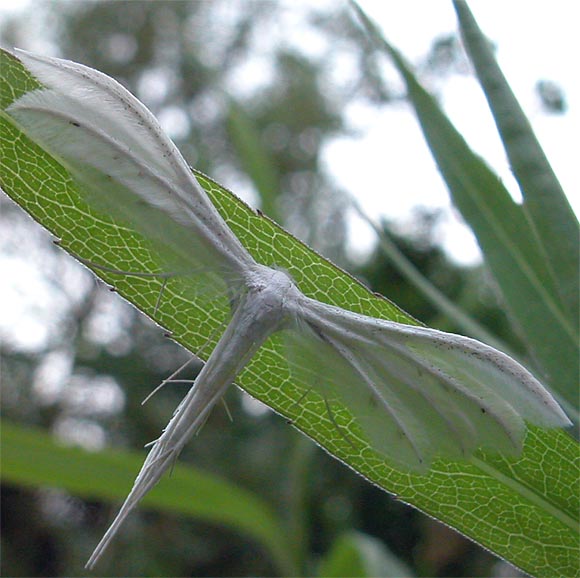- Plume moth
Taxobox
name = Pterophoridae

image_width = 250px
image_caption = White Plume Moth, "Pterophorus pentadactyla"
regnum =Animal ia
phylum =Arthropod a
classis =Insect a
ordo =Lepidoptera
subordo =Ditrysia
superfamilia = Pterophoroidea
familia = Pterophoridae
familia_authority = Zeller, 1841
type_species = "Pterophorus pentadactyla"
diversity = 90+ genera
1,000+ species
diversity_link = Lepidopteran diversity
subdivision_ranks = Subfamilies
subdivision =Agdistinae Deuterocopinae Macropiratinae Ochyroticinae Pterophorinae The Pterophoridae or plume-moth s are a family ofLepidoptera with unusually modified wings. The fore-wings consist of (usually) two curved spars with more or less bedraggled bristles trailing behind (compare the greater number of symmetrical plumes of theAlucitidae ). The hind wings are similarly constructed on three spars. A few genera have normal lepidopteran wings.The usual resting posture is with the wings extended laterally and narrowly rolled up. Often they resemble a piece of dried grass, and may pass unnoticed by potential predators even when resting in exposed situations in daylight. Some species have larvae which are stem- or root-borers while others are leaf-browsers.
Economically important pterophorids include the artichoke plume moth ("Platyptilia carduidactyla"), a pest in
California , while theGeranium plume moth "Platyptilia pica" and theSnapdragon plume moth "Stenoptilodes antirrhina" can cause damage to their respective host garden plants. Other plume-moths have been used as biological control agents against invasive plant species - "Lantanophaga pusillidactyla" againstshrub verbena "(Lantana camara)", and "Oidematophorus beneficus" againstmist flower "(Ageratina riparia)".For additional information and links to other plume moth sites, see: http://www.plumemoth.com/
Wikimedia Foundation. 2010.
